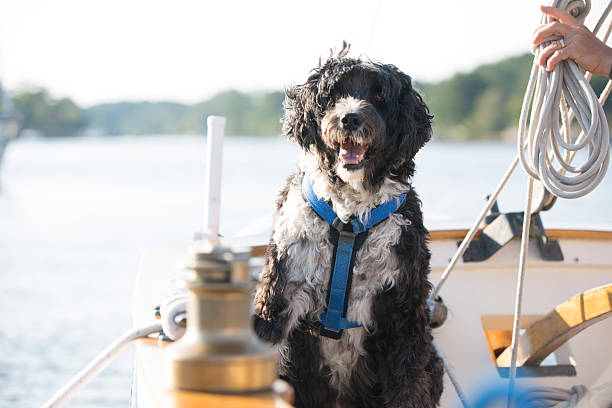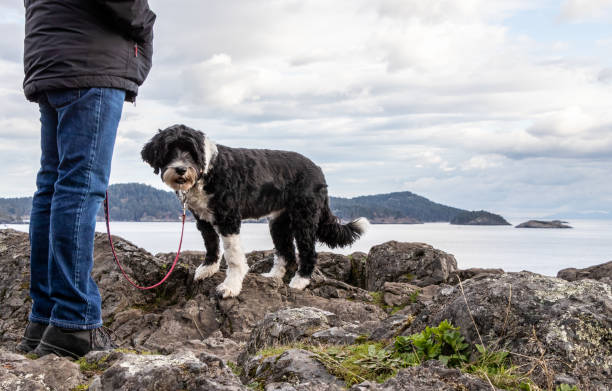Portuguese Water Dog

Breed History:
The Portuguese Water Dog (Cão de Água Português) is an ancient working breed that originated along the Algarve coast of Portugal. Bred to assist fishermen, these dogs were skilled at retrieving lost gear, herding fish into nets, and delivering messages between boats or to shore.
They were invaluable to the Portuguese fishing industry for centuries, but they nearly faced extinction by the 20th century due to modernisation. Thanks to the efforts of breeder Vasco Bensuade in the 1930s, the breed was revived and eventually recognised by the Portuguese Kennel Club and AKC (1984). Their intelligence and water-loving nature continue to make them a versatile working and companion dog today.
|
Gender |
Height |
Weight |
|
Male |
50-57 cm |
19-27 kg |
|
Female |
43-52 cm |
16-23 kg |
Size – Medium
Life Expectancy: 11–14 years

Breed Appearance:
The Portuguese Water Dog is a robust, athletic, and muscular dog with a curly or wavy coat that is hypoallergenic and water-resistant. Its body is slightly longer than tall, built for agility and swimming power.
It has a distinctive broad head, a rounded tail that curls at the tip, and webbed feet ideal for propulsion in water. Coat colours include black, brown, white, or parti-colour. Traditional grooming styles include the retriever clip or lion clip for historical and functional reasons.
Breed Type – Working/Companion:
Originally a working seafaring dog, the Portuguese Water Dog now excels as an active companion, therapy dog, and participant in canine sports. It is known for being loyal, energetic, and highly trainable.
These dogs form strong bonds with their families and are especially affectionate and playful. They do best with families who can match their activity level and are eager to engage with them regularly. Their sociable nature makes them good with children and other pets when properly socialised.

Training:
The Portuguese Water Dog is highly intelligent, eager to please, and responds exceptionally well to positive reinforcement methods. It excels in obedience, agility, water sports, and service roles due to its keen mind and adaptability.
Early socialisation and structured training are essential to prevent overexuberance or dominant behaviours. These dogs thrive when given mental tasks, and they enjoy learning new skills. Their enthusiasm and quick wit make training enjoyable but require consistent leadership.
Health & Care:
Generally a healthy breed, though susceptible to a few genetic conditions, including:
-
Hip dysplasia
-
Progressive retinal atrophy (PRA)
-
Juvenile dilated cardiomyopathy
-
GM1 storage disease (mostly eliminated through testing)
Regular health screenings by reputable breeders are essential. A balanced diet, routine check-ups, and regular exercise will help maintain good health throughout their lifespan.

Living Conditions:
Portuguese Water Dogs can adapt to apartment or house living, but they require ample exercise and mental enrichment to prevent boredom. They are best suited to active households and appreciate access to water or outdoor space.
These dogs do not tolerate boredom or isolation well. They crave interaction and need to be part of family life. Their dense coat provides moderate protection against the cold, though they prefer temperate climates.
Exercise:
This is a high-energy breed that requires at least 1 to 2 hours of exercise daily. Activities should include a mix of physical exertion and mental stimulation, such as:
-
Swimming
-
Fetch
-
Agility training
-
Scent work
-
Obedience drills
They excel in water-based sports and are happiest when given a job or routine. Without sufficient activity, they may become restless or destructive.
Grooming:
The Portuguese Water Dog’s coat requires regular maintenance. Brushing 2–3 times per week prevents matting and distributes natural oils. Many owners choose to clip the coat every 6–8 weeks to keep it manageable.
Routine care also includes ear cleaning, nail trimming, and dental hygiene. Since their coat doesn’t shed like typical breeds, regular grooming is essential to avoid tangles, especially after swimming.

Advantages:
-
Highly intelligent and trainable
-
Affectionate and loyal to family
-
Hypoallergenic, low-shedding coat
-
Excellent swimmer and working dog
-
Great for active households and canine sports
-
Sociable and generally good with children and pets
Disadvantages:
-
Needs high levels of daily exercise and engagement
-
Regular grooming is time-consuming
-
Can become bored or destructive without mental stimulation
-
It may be too energetic for sedentary homes
-
Prone to separation anxiety if left alone, often
-
Requires early socialisation to avoid dominant behaviour

